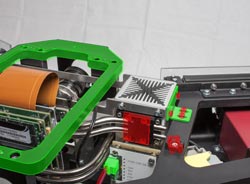Digital Assembly Inspection: Automatic Quality Control Even for Small Quantities

In model-based assembly inspection, software compares the digital target data of assembled components with the real outcome. Errors are detected immediately. (c) Fraunhofer IFF<br>
Manual assembly procedures are typical and assembly jobs change so steadily that automatic quality control has not been worthwhile. Novel software developed at the Fraunhofer IFF is an answer to this:
Using cameras, it compares the particular CAD data of a product digitally with the finished assembled product and can incorporate modifications with a click of the mouse. Our researchers will be presenting this technology at the Control trade fair (hall 1, booth 1502) in Stuttgart on May 14 to 17.
One day is like the next on automotive assembly lines: Typically, around one thousand vehicles roll off a line every day and workers execute the same actions many times. The situation is entirely different in the aircraft industry: Although the birds of steel are alike on the outside, every airline desires a different interior.
Where are the seats located? What should the overhead compartments look like? Technicians usually leaf through the documents on specific components to see where and how they should be mounted. At what angle do they have to be attached where with what bolts? Once a worker is finished their assembly, she or he rechecks whether everything is in the right spot and confirms that it is. They can overlook errors, though. Humans do not have the same level of concentration every day and they tire toward the evening. Quality inspectors therefore examine individual products closely yet one more time but are not able to inspect every single bolt –100 percent inspection is impossible with manual methods.
Manufacturers therefore want automatic quality control, especially when components are relevant to safety. Approaches to large quantities like those in the automotive industry already exist, which use software to compare assembled components with photographs taken beforehand. This is hardly worthwhile for small production lines, however: All of the components must be assembled first of all and then photographed in order to have reference images for further assembly. If, for example, an airline ordered only four aircraft with the respective interiors, the assembly of only just three could be monitored.
Digital Comparison of Assembled Products with CAD Data
A new technology will now take even the production of such small quantities another step toward defect-free manufacturing and reliable detection of assembly errors. It was developed by researchers at the Fraunhofer Institute for Factory Operation and Automation IFF in Magdeburg. “Rather than using photos of a real assembled component as a reference, we use virtual images to reproduce the ideal state, instead,” says Dr. Dirk Berndt, manager of the Measurement and Testing Technology Business Unit at the Fraunhofer IFF. To do so, the researchers developed software that creates a “photo” – of a product that has not yet even been assembled – from the CAD data and the particular camera positions. The principle: Once a technician has finished assembling a component, a camera takes a picture of it – as during conventional automatic inspection. Rather than comparing this picture with one taken beforehand, the software computes a virtual photo based on the CAD data, which has exactly the same perspective as the picture really taken. All of this is done in seconds, i.e. in real time. The software compares this virtual picture with the picture taken of the real component.
Components No Longer Have to Be Aligned Precisely
This technology has a number of benefits: It can already be used during the assembly of the first product and is therefore worthwhile even for very small quantities. If the CAD data change, only a mouse-click is needed to load the current data into the system. Furthermore, the software allows for the position in which the inspected component is placed before the camera and computes the virtual image accordingly. Thus, the component must not be positioned exactly in the scanned field. Conventional automatic quality control systems require that components be guided under the camera precisely. A comparison is impossible if they are not.
“The technology in and of itself has been developed and is close to being fully perfected,” says Berndt. The researchers intend to be using it in two prototype applications by the end of this year. The researchers will be presenting their technology at the Control trade fair (hall 1, booth 1502) in Stuttgart on May 14 to 17.
Media Contact
All latest news from the category: Trade Fair News
Newest articles

Parallel Paths: Understanding Malaria Resistance in Chimpanzees and Humans
The closest relatives of humans adapt genetically to habitats and infections Survival of the Fittest: Genetic Adaptations Uncovered in Chimpanzees Görlitz, 10.01.2025. Chimpanzees have genetic adaptations that help them survive…

You are What You Eat—Stanford Study Links Fiber to Anti-Cancer Gene Modulation
The Fiber Gap: A Growing Concern in American Diets Fiber is well known to be an important part of a healthy diet, yet less than 10% of Americans eat the minimum recommended…

Trust Your Gut—RNA-Protein Discovery for Better Immunity
HIRI researchers uncover control mechanisms of polysaccharide utilization in Bacteroides thetaiotaomicron. Researchers at the Helmholtz Institute for RNA-based Infection Research (HIRI) and the Julius-Maximilians-Universität (JMU) in Würzburg have identified a…



